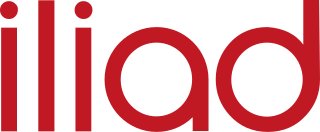Telecommunications in Ireland operate in a regulated competitive market that provides customers with a wide array of advanced digital services. This article explores Ireland's telecommunications infrastructure including: fixed and mobile networks, The voice, data and Internet services, cable television, developments in next-generation networks and broadcast networks for radio and television.
The most important telecommunications in Italy are telephone, radio, television and the Internet.
Telecommunications in Uruguay includes radio, television, telephones, and the Internet.

FASTWEB S.p.A. is an Italian telecommunications company that provides fixed and mobile telephony, broadband Internet and IPTV services. It is also one of the prominent companies in Italy providing FTTH connections, and is a subsidiary of the Swiss telecommunication company Swisscom AG.

Fiber to the x or fiber in the loop is a generic term for any broadband network architecture using optical fiber to provide all or part of the local loop used for last mile telecommunications. As fiber optic cables are able to carry much more data than copper cables, especially over long distances, copper telephone networks built in the 20th century are being replaced by fiber.

Vodafone Italia S.p.A. is an Italian telecommunications company, subsidiary of Vodafone Group Plc. It has 30,153,000 mobile phone customers and 3,182,000 fixed phone lines, with respectively a market share of 28.5% and 16%. The company's headquarters are in Ivrea (TO) and Milan.

Free S.A.S. is a French telecommunications company, subsidiary of Iliad S.A. that provides voice, video, data, and Internet telecommunications to consumers in France. Its head office is in the 8th arrondissement of Paris and it is the second-largest ISP in France.
Vodafone Portugal – Comunicações Pessoais, S.A., a full subsidiary of the Vodafone Group, is the second mobile operator in Portugal, both chronologically and in market share. Its competitors are NOS and MEO.
Internet access is widely available in New Zealand, with 94% of New Zealanders having access to the internet as of January 2021. It first became accessible to university students in the country in 1989. As of June 2018, there are 1,867,000 broadband connections, of which 1,524,000 are residential and 361,000 are business or government.
Internet in Brazil was launched in 1988, becoming commercialy available in May 1995. As of 2023, Brazil ranked fifth in the world with 181.8 million internet users. The country had an internet penetration rate of 86.6% as of January 2024. In March 2024, Brazil ranked 27th in the Ookla Broadband Ranking, with a median fixed broadband speed of 158.57 Mbit/s. Also, as per December 2021, Brazil had 41,4 million fixed broadband accesses, most of them FTTH. However, as per 2020, most Brazilians access the Internet through a mobile connection, with more than 200 million mobile internet access.
The prevalent means of connecting to the Internet in Germany is DSL, introduced by Deutsche Telekom in 1999. Other technologies such as Cable, FTTH and FTTB (fiber), Satellite, UMTS/HSDPA (mobile) and LTE are available as alternatives.

The United Kingdom has been involved with the Internet throughout its origins and development. The telecommunications infrastructure in the United Kingdom provides Internet access to homes and businesses mainly through fibre, cable, mobile and fixed wireless networks, with the UK's 140-year-old copper network, maintained by Openreach, set to be withdrawn by December 2025.
Broadband Internet in Israel has been available since the late 1990s in theory, but it only became practically accessible to most customers in 2001. By 2008, Israel had become one of the few countries with developed broadband capabilities across two types of infrastructure—cable and DSL—reaching over 95% of the population. Actual broadband market penetration stands at 77%, ranked 7th in the world. In 2010, Israel was ranked 26th in The Economist's Digital Economy Rankings. In 2022, Israel was ranked first for digital quality of life by Surfshark.

Iceland is among the top countries in the world in terms of Internet deployment and use. 99.68% of Icelanders used in the internet in 2021.
In Romania, there are 18.8 million connections to the Internet. Romania's country code is .ro. The .eu domain is also used, as it is shared with other European Union member states. There were over 600 000 domains registered under .ro at the end of 2012.
10G-PON is a 2010 computer networking standard for data links, capable of delivering shared Internet access rates up to 10 Gbit/s over existing dark fiber. This is the ITU-T's next generation standard following on from GPON or Gigabit-capable PON. Optical fibre is shared by many subscribers in a network known as FTTx in a way that centralises most of the telecommunications equipment, often displacing copper phone lines that connect premises to the phone exchange. Passive optical network (PON) architecture has become a cost-effective way to meet performance demands in access networks, and sometimes also in large optical local networks for "Fibre-to-the-desk".

Telecom Italia Mobile S.p.A., commonly known as TIM, is an Italian telecommunications company owned by Telecom Italia S.p.A. Founded as a mobile telephony company in 1995, since 2015 it provides mobile, fixed telephony, and Internet services.

Iliad Italia S.p.A. is an Italian telecommunications company, wholly-owned subsidiary of the French group Iliad SA

Elisabetta Ripa is an Italian businesswoman, CEO of Enel X Way since April 2022 and Advisory board of IAB Italia, a consultative body established to promote digital culture. As a successful Manager, Forbes included her among the 100 most successful Italian women in 2019.









